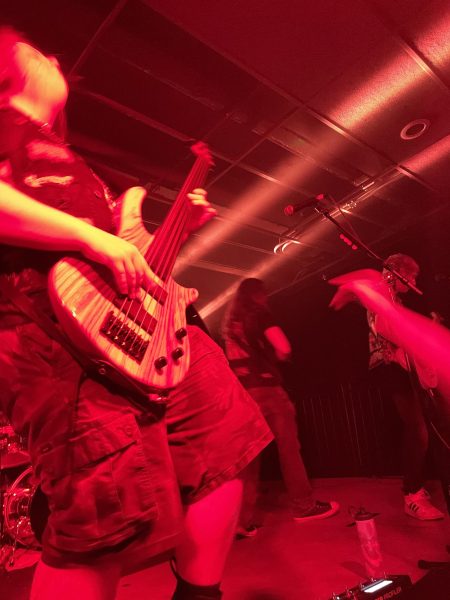Seniors Arden Lillemoe and Reilly Ringness trade large concerts in the Xcel Energy Center or U.S. Bank Stadium for small-venue local shows. They both stumbled upon the local punk and metal scene a bit on accident, but have found it hard to keep away.
“I’m not part of the scene necessarily, but I do enjoy going to shows,” Lillemoe said. “At some point, I went to a show with a friend, and then I wanted to go to more.”

Image submitted by Reilly Ringness.
Artists and bands of all genres take to Twin Cities stages all days of the week. However, it is punk music in particular that strikes a chord with Lillemoe and Ringness.
“When I go, it’s usually punk shows. Sometimes death metal shows because I have a co-worker that’s in a death metal band,” Lillemoe said. Ringness also has a co-worker involved in death metal, so the two share a similar connection to the local scene.
Punk music is expansive and contains many subgenres under its umbrella. The genre originates in the ‘60s Punk rock movement, centered largely in New York City and Detroit. Bands such as The Velvet Underground and the Talking Heads were formative groups in the early years of punk. In rebellion against mainstream corporate culture, punk music is often countercultural in its lyrics, production, and performance. Many punk shows take place in personal homes that double as house venues. These intimate spaces provide a haven for members of the local scenes, especially for those in the LGBTQ community. In the Twin Cities, the punk and queer communities hold close ties.
“[Shows] are really fun and enjoyable and they are a great opportunity to meet other teens in the Twin Cities,” Ringness said.
These shows can be lively and packed with people, which can be a draw or a deterrent. For Lillemoe, the energy and noise are an essential part of the punk experience.
“When the chorus comes on, everyone yells and moshes. I enjoy being sweaty and bumping around with other people,” Lillemoe said.
Ringness disagrees.
“I do not like being sweaty. I do not like moshing. I hide in the corner,” he said.
Ringness is not a fan of the crowd itself but loves the opportunity to connect with other young people who make up the mosh.
“I really like seeing people in the Twin Cities and I like to make friends, and I like hearing music,” he said.
Punk shows draw many of the same people, making up the local music community. Lillemoe and Ringness like to observe from afar.
“It’s a little intimidating, They all know everything about each other, and I don’t know anything about any of them,” Lillemoe said.
“They’ve all dated each other and they all hate each other,” Ringness added.
The punk scene is a robust social setting filled with familiar characters onstage and in the crowd. The tight-knit nature of the community lends itself to much more than enjoying music. Members of the punk scene often contribute to mutual aid, both through benefit concerts and fundraisers that float through the community. This summer, the Twin Cities punk community was rocked by a shooting at a local house venue in which one person, August Golden, was killed, and six injured.
The shooting is thought to be motivated by anti-LGBTQ hate.
The August mass shooting fractured the perceived safety of the scene and its venues, yet also brought the community together in grief. Community members hosted shows in Golden’s memory and raised funds for loved ones.
Punk remains an alive and supportive scene throughout its rich history.
Looking to support local bands? Check out Barnacle, she’s green, Oyster World, or Kids Ski Free.
Don’t know where to start? Listen to Wisteria by Minneapolis shoegaze band, she’s green.